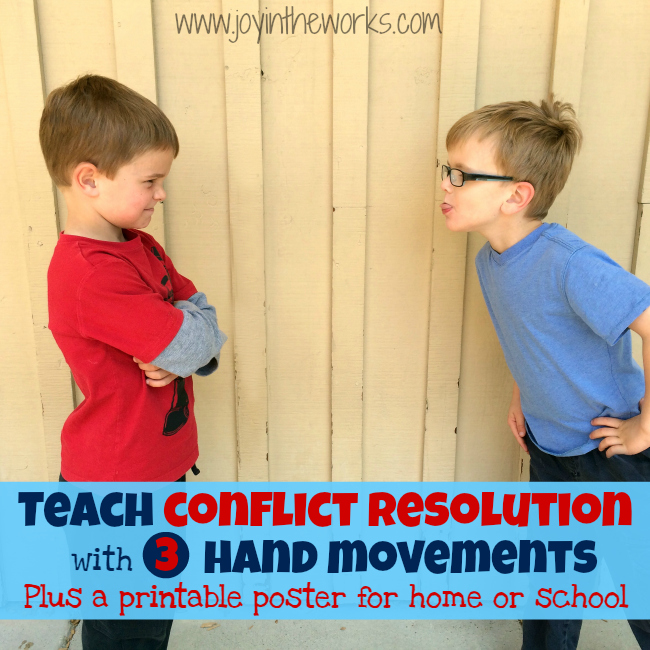We do so much to get our kids ready for a new school year. We buy a new backpack, a new lunchbox and new clothes. We check their shoes, cut their hair and pack up the 300 required glue sticks. We get them physically ready to start school, but I think there are some things we can do to prepare them emotionally as well. I think the start of a brand new school year is a great opportunity to teach (or simply remind them) about how to handle conflict and problems with friends. In our house, we have developed a system has 3 simple hand movements in order to teach conflict resolution.
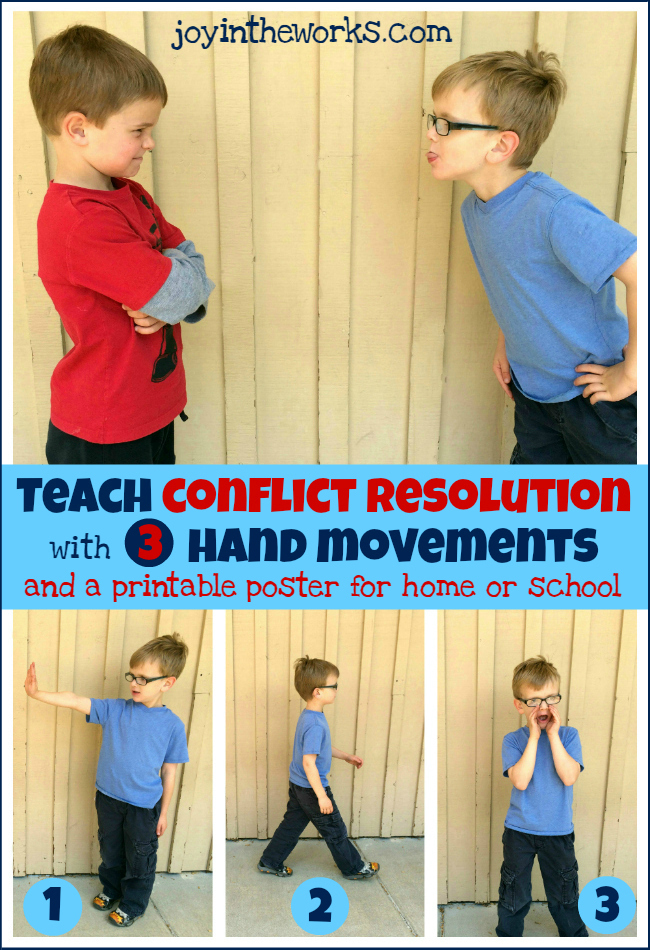 We all know that as moms, one of our major roles is as a referee and a mediator between siblings. (He touched me! She ate my cereal! She stared at me!) However, as a former teacher of young children as well, so much of my job in the classroom also involved dealing with conflict between children and frequent “tattling”. It wasn’t uncommon for me to spend more time helping children work through social problems than I did teaching them their ABC’s! Fortunately, I actually believe that it was one of the most important aspects of my job as an educator. We won’t always be there to help solve their problems with their friends. Just like we won’t always be there to decide who gets the bigger cookie at home. It is our job as parents (and educators) to train and guide them through these kinds of conflicts. But that doesn’t mean we need to hear about every single one, the instant it happens! =)
We all know that as moms, one of our major roles is as a referee and a mediator between siblings. (He touched me! She ate my cereal! She stared at me!) However, as a former teacher of young children as well, so much of my job in the classroom also involved dealing with conflict between children and frequent “tattling”. It wasn’t uncommon for me to spend more time helping children work through social problems than I did teaching them their ABC’s! Fortunately, I actually believe that it was one of the most important aspects of my job as an educator. We won’t always be there to help solve their problems with their friends. Just like we won’t always be there to decide who gets the bigger cookie at home. It is our job as parents (and educators) to train and guide them through these kinds of conflicts. But that doesn’t mean we need to hear about every single one, the instant it happens! =)
While there a lot of amazing programs, curricula and books out there that teach general social skills to children in the classroom or get to the heart of the issue with sibling rivalry at home, I needed something quick and easy for my kids to utilize when they encountered a problem. And mostly, I needed it not to involve running to me first thing! So I developed these 3 easy steps to teach conflict resolution. And it must be the former teacher in me that saw the need to add some simple hand movements to help make it more fun and memorable. (Oh and if they can’t remember it that way, I had a comic strip drawn as well, so that you can print it out and hang it up in your house or classroom. It is available in my store in a smaller 8.5×11 size here and an 11×17 poster here)
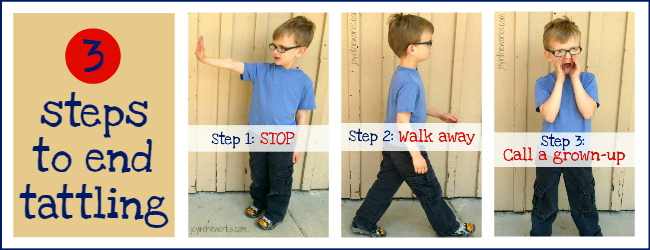
Teach Conflict Resolution with 3 Hand Movements
Step 1: Stop The first step in teaching conflict resolution involves using your hand to make a stop sign. It isn’t as simple as one kid yelling “Stop it” in some mean or whiny voice, however. The hand movement for the stop sign is simply a reminder that before a child goes to a grown-up for help, they need to tell the other person to stop what they are doing because they don’t like it. We often practice an appropriate way to say this and sometimes it might include something like an “I message” (i.e. I feel mad when my toy gets taken away from me) depending on the age group. Hopefully this simple, yet powerful step will end the conflict right away and diminish the need to run to a teacher or parent for help with another child’s behavior. However, if it doesn’t, then I teach children to move on to Step #2.
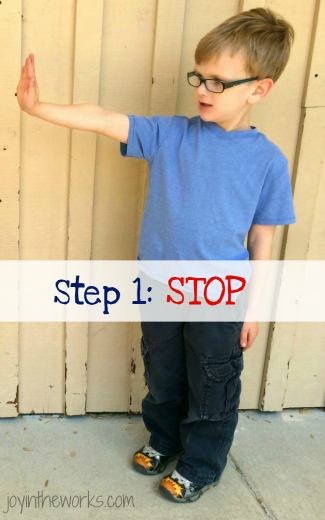 Step 2: Walk Away If a child tells another child to please stop what they are doing because it bothers them or makes them angry and the child doesn’t stop, I tell them it is time to walk away. Sometimes this might mean going and playing with someone else or finding something else to do. The child essentially needs to walk away from the issue if they aren’t having luck using their words. Incidentally, if you are teaching the hand movements to go with these steps, we swing our arms at our side to indicate “walk away”.
Step 2: Walk Away If a child tells another child to please stop what they are doing because it bothers them or makes them angry and the child doesn’t stop, I tell them it is time to walk away. Sometimes this might mean going and playing with someone else or finding something else to do. The child essentially needs to walk away from the issue if they aren’t having luck using their words. Incidentally, if you are teaching the hand movements to go with these steps, we swing our arms at our side to indicate “walk away”.
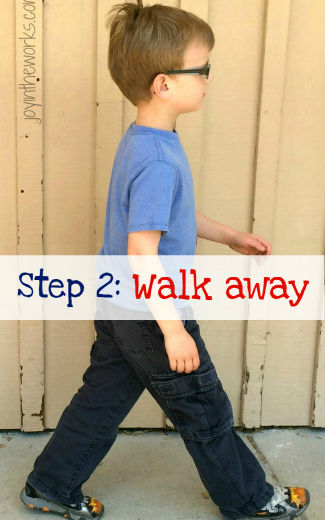 Step 3: Call a Grown-Up Now we all know that sometimes steps #1 and #2 don’t work. The offending child won’t listen and keeps following the other child around, bothering or pestering him. For me, I felt like this was an appropriate time for the child to call in reinforcements. At a young age, the child has used his words (by saying stop with step#1) and tried to separate himself from the problem (with step#2). Those are pretty big feats for a young child! (Side note: Just because Step #3 is using hands cupped around the face to remind children to call a grown-up to help, it doesn’t mean they should actually yell across the room or play ground to get our attention! Again, it is just a symbol that acts as a simple kinesthetic reminder about what to do next).
Step 3: Call a Grown-Up Now we all know that sometimes steps #1 and #2 don’t work. The offending child won’t listen and keeps following the other child around, bothering or pestering him. For me, I felt like this was an appropriate time for the child to call in reinforcements. At a young age, the child has used his words (by saying stop with step#1) and tried to separate himself from the problem (with step#2). Those are pretty big feats for a young child! (Side note: Just because Step #3 is using hands cupped around the face to remind children to call a grown-up to help, it doesn’t mean they should actually yell across the room or play ground to get our attention! Again, it is just a symbol that acts as a simple kinesthetic reminder about what to do next).
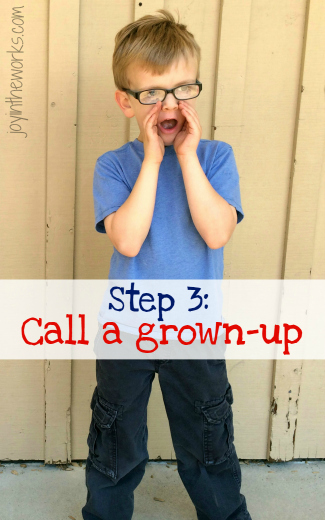 At this point, I believe it is a good idea to intervene and help mediate as the children work out a solution together. Notice I didn’t say this was a good time to get in there and solve the problem, make the kid apologize and send them on their way. When we are teaching (and raising) children, I believe we should take these opportunities to actually instruct children on appropriate social skills and behavior. Some say we should just leave kids alone to work things out on their own and while I think that can have a place with older children, it is the younger years where children must be implicitly taught social skills and how to handle conflict with others. I usually do that in this final step by modeling some behavior and statements that might be appropriate to the situation. I also encourage the children to come up with their own solutions and compromise. I am always so impressed when that happens!
At this point, I believe it is a good idea to intervene and help mediate as the children work out a solution together. Notice I didn’t say this was a good time to get in there and solve the problem, make the kid apologize and send them on their way. When we are teaching (and raising) children, I believe we should take these opportunities to actually instruct children on appropriate social skills and behavior. Some say we should just leave kids alone to work things out on their own and while I think that can have a place with older children, it is the younger years where children must be implicitly taught social skills and how to handle conflict with others. I usually do that in this final step by modeling some behavior and statements that might be appropriate to the situation. I also encourage the children to come up with their own solutions and compromise. I am always so impressed when that happens!
With these simple steps, I have been able to circumvent a lot of tattling and social problems at school (and in the house!) from coming straight to me without any effort to solve the problem on their own. Now when a child comes up to me, I might say, “Did you try the first 2 steps before you came to get me?” and we would review them right then and there as well. Plus, they love the hand movements that go with the steps! Someday I will make lesson plans (and a song?!) to accompany the hand movements, but for now, with my kids, I just teach them the steps as needed. I did have a fun comic strip designed for you, if you want to print it out and use it in your home or classroom. You can download it from the store in 2 different sizes. Here is the regular 8.5x11in printable and here is the 11x17in poster. Hope it works as a good reminder in the classroom and at home!
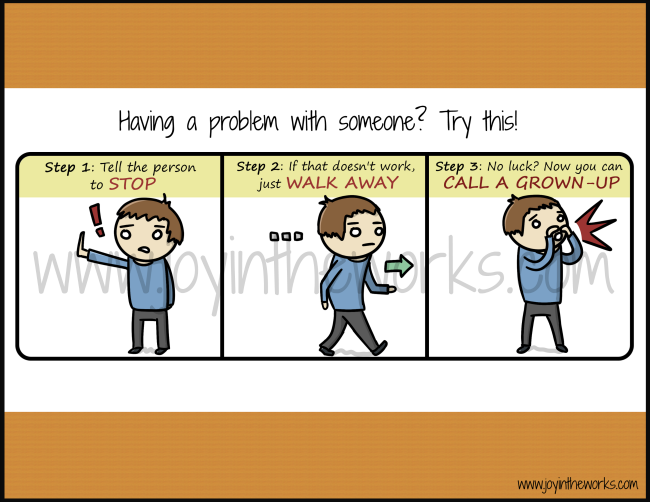 I know this isn’t a perfect solution (and won’t always work) and social skills and behavioral expectations require of ton of teaching of the bigger concepts, but I feel like this is a good, simple start. These 3 easy steps to teach conflict resolution encourage independence in children and teach them that they are strong and powerful enough to solve a problem on their own. Remember, the quicker we jump in and solve for them, the more incapable and helpless they feel! I think one of our goals is to raise, independent, capable children ready to take on the world! Hopefully this will help! =)
I know this isn’t a perfect solution (and won’t always work) and social skills and behavioral expectations require of ton of teaching of the bigger concepts, but I feel like this is a good, simple start. These 3 easy steps to teach conflict resolution encourage independence in children and teach them that they are strong and powerful enough to solve a problem on their own. Remember, the quicker we jump in and solve for them, the more incapable and helpless they feel! I think one of our goals is to raise, independent, capable children ready to take on the world! Hopefully this will help! =)
